

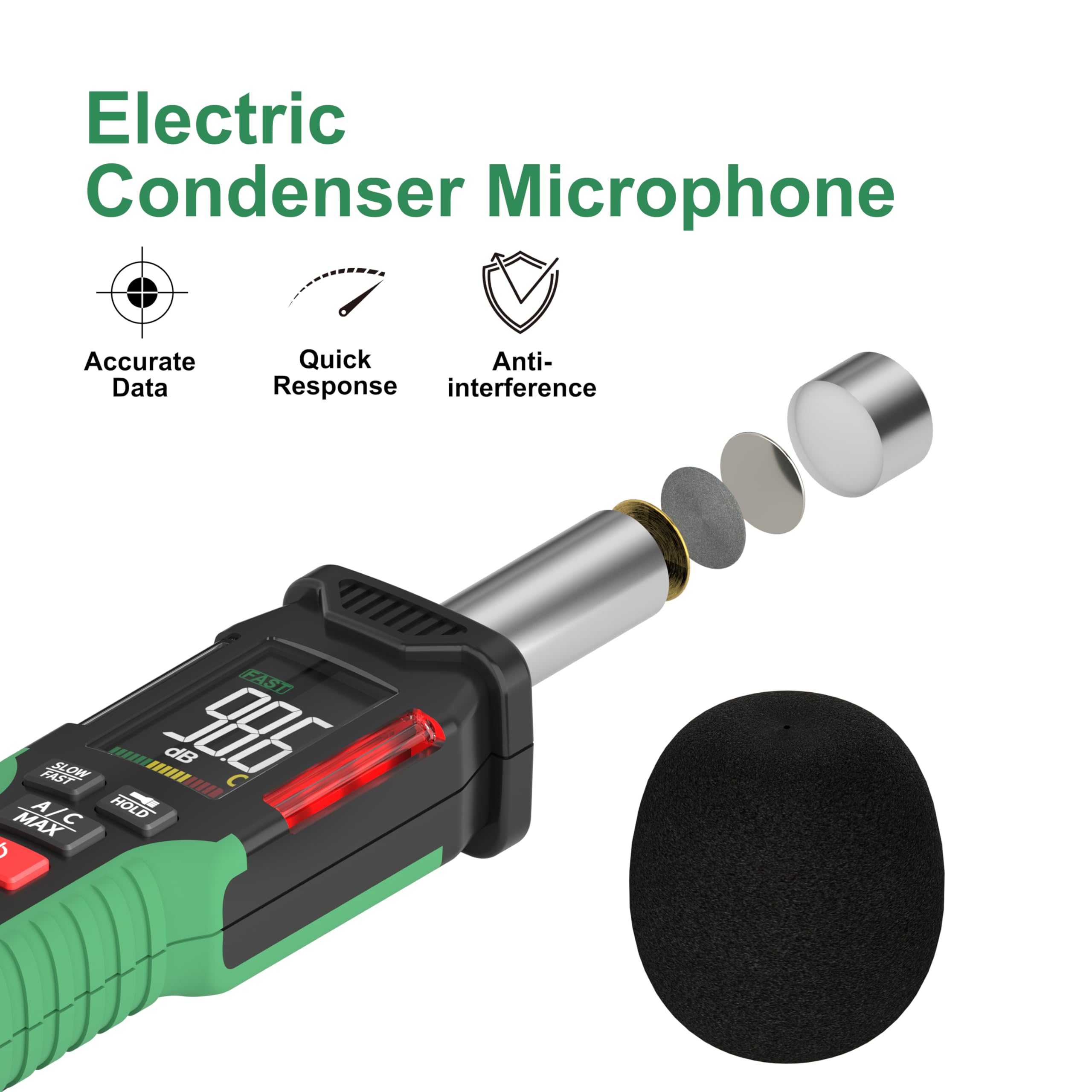
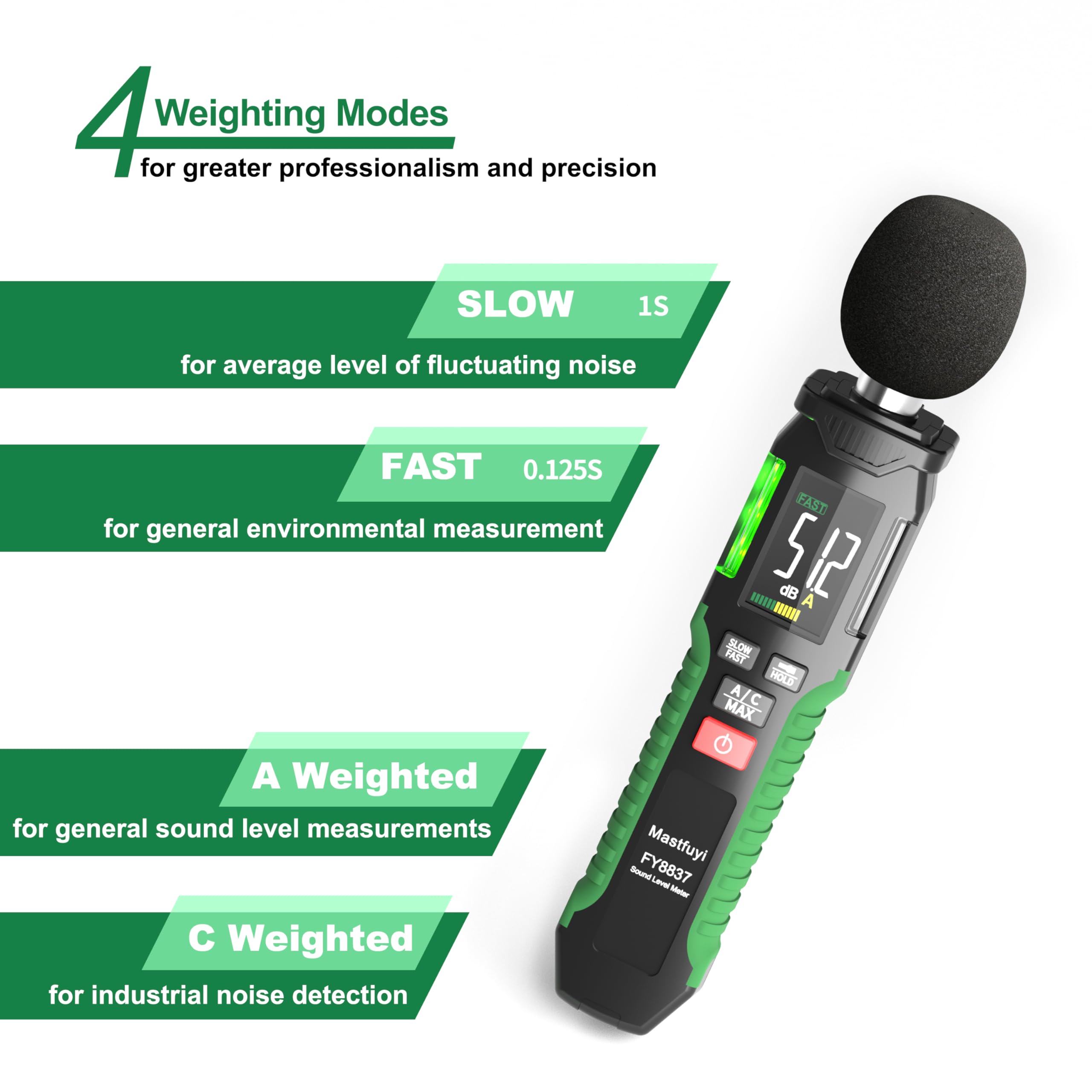


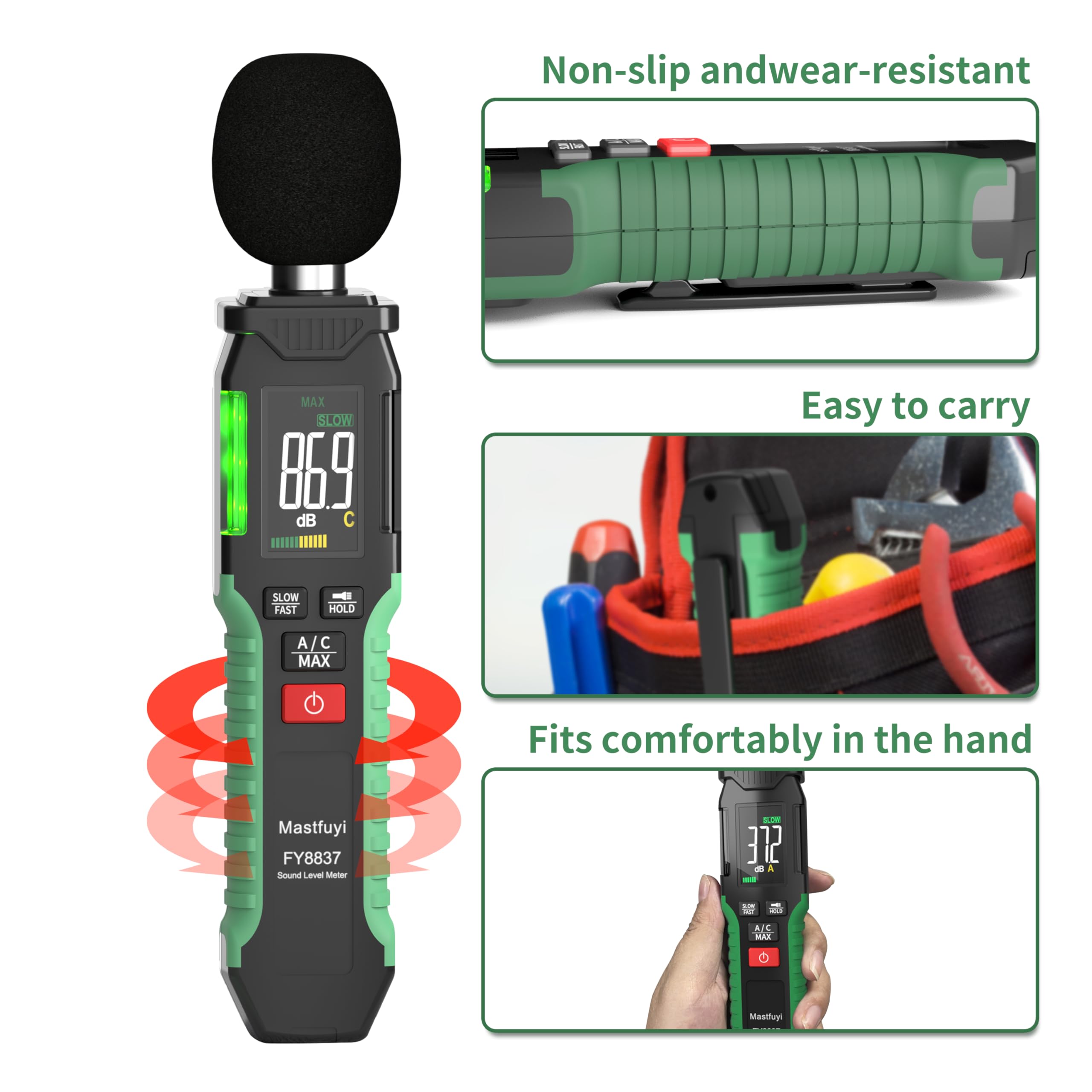
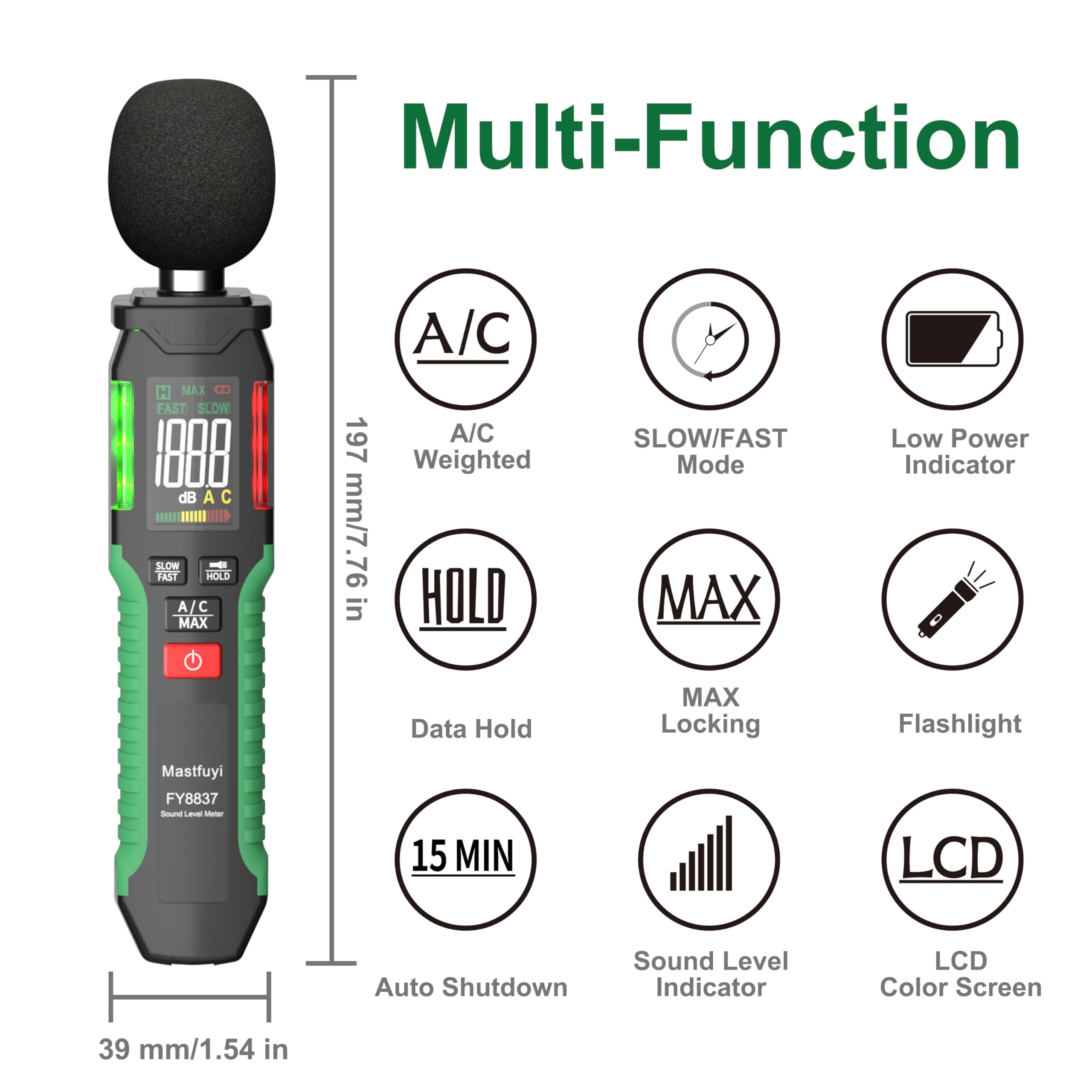

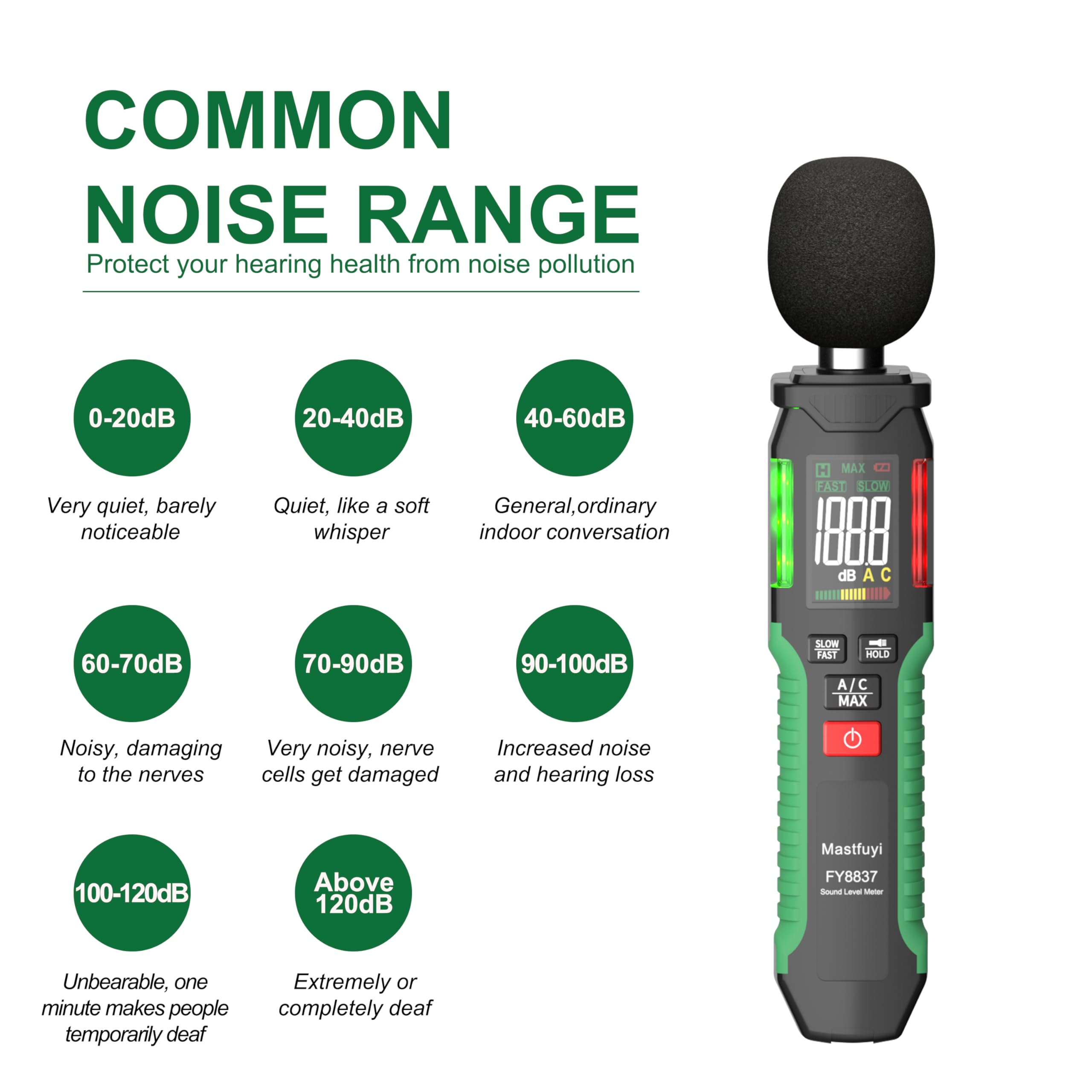






🔊 Measure the noise, master the silence!
The Mastfuyi Decibel Meter is a high-accuracy sound level measuring device that ranges from 30-130 dB with A/C weighting options. It features a compact design, a user-friendly LCD display, and dual visual alerts for sound levels, making it ideal for various environments such as homes, offices, and factories. With a 48-month warranty and built-in flashlight, this portable SPL meter is perfect for professionals who need reliable noise measurement on the go.
T**D
To test my AVR and speaker.
Works awesome and love it.
D**R
You'd need a calibrated source to be sure but it seems to do a decent job
I bought two different brand/models of sound meter. Since they can be found so cheap it was worth getting a second to compare results. In a room with a background reading of just under 40dB, using the slow update rate, both using the A weighting, this meter is typically within about 1 or 2dB of the other meter:Ambient sound levelMusic at a pleasant volumeWhite noisea 10 second 30Hz to 8kHz sweep (covering the documented frequency response)Testing with a tone generator at 1kHz I also see deltas close enough to 3dB when halving or doubling the output amplitude. The sources aren't calibrated, an Android audio signal generator app via a bluetooth speaker that has dedicated filtering for music.However, since both meters have a stated accuracy of +/-1.5dB with 0.1dB resolution I'm comfortable with the A weighting mode on this device.In the C weighting mode the reading from the two meters differ typically by around 6dB using the same sources and peak difference is about 10dB. That is pretty severe (typically 4x linear difference and up to 10x linear difference between the two meters using C weighting). I wasn't using sources with high audio power, just the same ones as I tested the A weighting with. Of the two meters I bought I suspect this model the less accurate in the C weighting mode and typically over-reads the real audio power level.Without a calibrated signal source these observations are only illustrative speculation rather than verification of anything.The live level meter is really just a stepped scale with three levels, green, yellow and red shown on a horizontal bar with six segments for each color and the expected purposes for the colors. It would be nicer if each individual bar segment was used individually to implement a live meter view. Above 50dB a rather annoying set of 3 yellow/greed LEDs is lit on the left of the LCD display, it makes sense if the level is persistently above 50dB for hours according to government data but probably not significant in a case like music that just exceeds 50dB repeatedly and flashes the LEDs. Above 90dB a set of 4 red LEDs lights on the opposite side of the LCD display. In both cases the LEDs are quite distracting from the meter reading.The fast update mode is 8 times per-second for the displayed dB level on the LCD and is probably great for adjusting a source of a stable signal but I have to say I prefer the slow mode with an update per-second due to the less volatile and eassier to read meter number. This is a place where a true bar meter updating 8 times per-scond while the dB level number updating every second would be quite useful.It's a shame it can only show the maximum sound levels, my other meter has a min and max view which is a nicer perspective. Both have a button to hold the currently displayed level which can be helpful trying to judge the effective level at some point when using the high speed update rate.It comes with what seems to me like a nice microphone pop filter that seems to me to be better than the one supplied with the other sound meter I bought. It has a belt clip and the battery cover has a screw to secure it. It's does quite a good job of filtering out user handling noise. But is easily distracted by simple sounds like moving things near it.It's a shame there is no cover for the microphone other than the pop filter, when unused for long periods the pop filter will take any bumps.On the whole I'm quite happy using it to compare sound sources, particularly using the A weighting. The not 5 star is only because of things like the coarseness of the bar level meter, the high (yellow/green) and severe (red) level LED indicators being so bright and close to the LCD view.
T**B
Good quality, worked as listed
Easy to use and perfect for balancing my 9.2 multi channel sound system
S**3
Really nice sound level meter
It's hard to believe you can get an accurate sound level meter at this price point.This Mastfuyi FY8837 works great! It is advertised with 1.5 decibel accuracy. A nearly silent room is about 30 Db.The meter comes with 2 AAA batteries an instruction booklet in several languages and a wind screen.I'm a drummer and have always wanted to know how loud a cymbal crash or a tom fill is. Now I know! No wonder I have some hearing loss after 35 years of playing. This sound level meter will come in handy for many projects.My favorite feature is that is has 3 green LEDs on the left side that stay lit up to 90Db. The right side has 3 red LED's that light up for anything 90Db and above. The hold function is also nice.If you press the A/C/MAX button will show:A-what the human ear hearsC-actual loudnessMAX-locks the LCD display to show the loudest a sound is. For example I placed it next to a speaker and long pressed MAX. It is holding at 117.3 Db. It will stay at this level until either I press the MAX button again or a sound registers louder than 117.3 Db. Very handy!CThis meter also has a hold function that allows you to 'freeze' the display so you can document an accurate measurement. The SLOW/FAST button works great as a refresh rate. SLOW will update the display ever 1 seconds. The FAST setting will update every 125 milliseconds.There is also a built in white LED that can be turned on by pressing the HOLD button for 2 seconds. This will light up a pretty large area in a dark room.Overall this is a very accurate meter that I think will come in handy for most users.
J**Y
Nice build, Easy to operate
I found this easy to operate. A couple of the buttons are overloaded with long press functionality, but the labeling is inconsistent about positioning. For example, flashlight uses long press and is on top, but Maximum mode also uses long press, and it's legend is occupies the bottom. Fortunately nothing's too complex here.In fast mode it seems to update 2-3 times a second. In slow mode it takes about 3 seconds to update. The hold and max features work as expected. Switching any other feature causes max and hold to switch off though.It can't measure quick noises (mentioned in the manual), like a hammer striking a surface. It is good for noise levels, or even semi-regular noise like speech.The flashlight just blinks as long as I hold the button, then when the button is released it turns on hold just like a short press would. Not sure if that's the intended behavior. I can't think of a use for this. The manual just says "long press to turn on or off the flashlight".There is a useless bar graph at the base of the display. It is broken into 18 segments, but only represents three ranges. Above 50 dBA the second (yellow) segment turns on, and three green LEDs to the left of the display light up. Above 90 dBA the third (red) segment turns on, and three red LEDs to the right of the display light up.Device weighs 140g (~5oz). Can be set on a flat surface facing up (most stable), or on either side. The main body is plastic with overmolded green rubber. The case is sturdy with 6 screws holding it together, and a channel for the two halves to interlock. The microphone is a tiny capsule mounted inside the metal head. This metal head weighs about 44g on its own. The battery compartment closes with a screw, and that has a proper brass insert.== Internals ==On the power side we have Holtek 7533-1 3.3V regulator, and Holtek HT7660 voltage converter (produces negative of the input voltage).There are two TL062C low-power dual op-amps. Then a couple TI CD405x multiplexers, however one has a questionable logo. The rest of the parts are three unknown 8-pin chips, and a large 64-pin QFP with custom marking.
Trustpilot
1 month ago
1 month ago